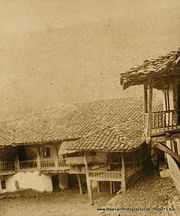Radoslav Hlapen
| Radoslav Hlapen [Lord of] Edessa, Veria, and Kastoria | |
|---|---|
| Born | ca. 1322 |
| Died | between 1383–1385[1] |
| Allegiance |
|
| Years of service | ca. 1331–1355 |
Radoslav Hlapen (Serbian: Радослав Хлапен; 1322-1383) was a voivode (military commander) and provincial lord in the service of Emperor Dušan the Mighty (r. 1331-1355) of the Serbian Empire. He took part in the conquest of Byzantine Macedonia, and was given a region north of Thessaly to govern in the early 1350s.
Life
Radoslav was born around 1322. According to John VI Kantakouzenos, the Byzantine emperor (1347 to 1354), Radoslav was "truly among the most notable [of Serb nobility], a relative of Dušan (Stephen Uroš IV)". He participated in the expansional military operations (Macedonia) in the 1340s, and by the early 1350s he was appointed governor of Edessa (Slavic: Voden), Veria, and Kastoria, just north of Thessaly.[2]
Emperor Dušan died in Devoll, on 20 December 1355. Dušan was succeeded by his son Stephen Uroš V "the Weak". After the violent death of the governor of Thessaly caesar Preljub (1356), Preljub's son Thomas' claim to the region was asserted by the widow Irene. The Preljubović family was forced to flee to Serbia after the advance of Nikephoros II Orsini in 1356. Irene married Radoslav Hlapen, who adopted Thomas.

Despot Simeon Uroš, the brother of Dušan, was appointed governor of Epirus and Acarnania in 1348. Following the death of Dušan and subsequent invasion of Nikephoros II, Simeon Uroš retreated to Kastoria, where he proclaimed himself "Emperor of Serbs, Greeks and Albanians".[2] Simeon Uroš acquired the support of John Komnenos Asen (the brother-in-law of Dušan).[2] In response, the Serbian nobility held a council in April 1357 at Skopje, in which they vowed to support Emperor Uroš, according to Dušan's will.[2] In the summer of 1358, Simeon Uroš advanced on Zeta but was stopped at Skadar, where his army of 5,000 men was defeated by the Serbian nobility.[3] Simeon Uroš returned to Kastoria, and never again tried to acquire Serbia.[2] During the absence of Simeon Uroš in Epirus (1359), Hlapen invaded Thessaly on behalf of his stepson Thomas. Simeon Uroš was forced to cut his losses by recognizing Radoslav Hlapen's conquests, turning over Kastoria to him, and marrying his daughter Maria to Thomas. Hlapen continued to recognize Uroš' suzerainty, and provided a buffer between Uroš V and Simeon Uroš.[4] After the treaty between Hlapen and Simeon Uroš, the latter settled in Thessaly.[4]
He retired as a monk in the Vodoča monastery where he also was buried, a votive ring was found at the site.[5] He also founded a church in Kučevište, Skopje.[5]
Family
He married Irene, the widow of caesar Preljub, and had three daughters:
- Maria Angelina Radoslava, married Alexios Angelos Philanthropenos
- Jelena, married Prince Marko
- Unnamed, married Nikola Bagaš (Nicholas Pagases)[6]
References
- ↑ „Istorija srpskog naroda II“ (1982), p.
- ↑ 2.0 2.1 2.2 2.3 2.4 Fine, p. 347
- ↑ Fine, p. 348
- ↑ 4.0 4.1 Fine, p. 350
- ↑ 5.0 5.1 Byzantinoslavica, pp. 187-191
- ↑ Istorija: spisanie na Sojuzot na istoriskite društva na SR Makedonija (in Macedonian). Sojuz. 1974. p. 202. "Во врска со ова можно е, на пример, да се претпостави дека тој „жу- пан Никола" е — Никола Пагаси Балдуин, едан од феудал- ните владетели на југозападна Македонија и зет на Радослав Хлапен (позната е неговата грамота од 1385 год.)"
Sources
- Fine, John Van Antwerp (1994), The Late Medieval Balkans: A Critical Survey from the Late Twelfth Century to the Ottoman Conquest, University of Michigan Press, ISBN 978-0-472-08260-5
- Nicol, Donald MacGillivray (1993), The Last Centuries of Byzantium, 1261–1453, Cambridge University Press, ISBN 978-0-521-43991-6
- Soulis, George Christos (1984), The Serbs and Byzantium during the reign of Tsar Stephen Dušan (1331–1355) and his successors, Dumbarton Oaks, ISBN 0-88402-137-8